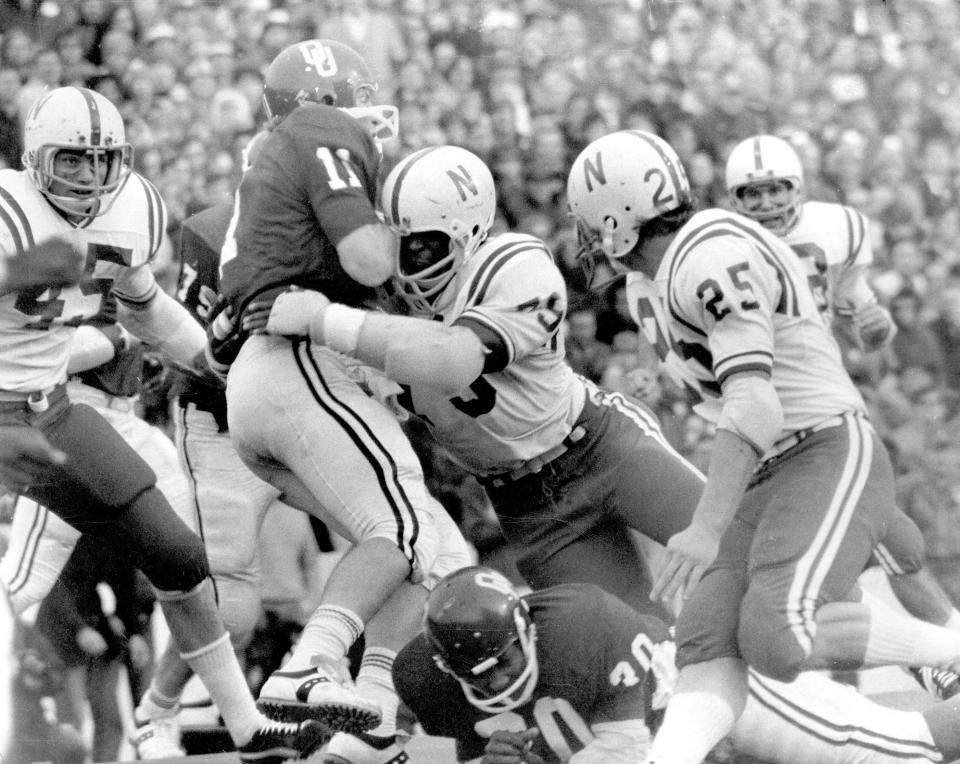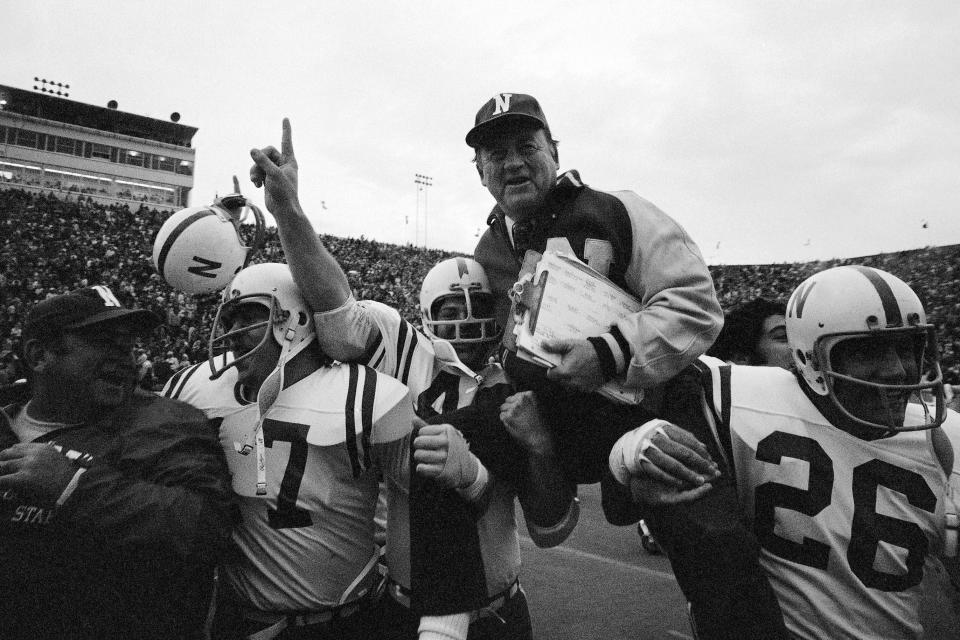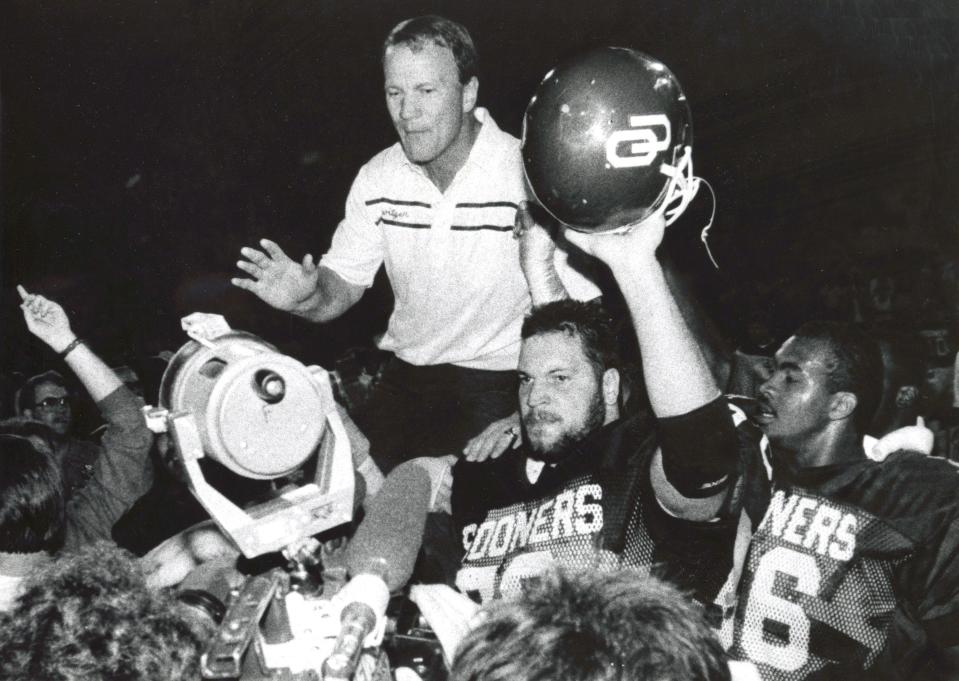College football Game of the Century? Nebraska-Oklahoma gem from 1971 holds up 50 years later
- Oops!Something went wrong.Please try again later.
- Oops!Something went wrong.Please try again later.
- Oops!Something went wrong.Please try again later.
- Oops!Something went wrong.Please try again later.
When the hype before the game is overshadowed by the play on the field, you get an all-time classic. And when the teams are ranked No. 1 and No. 2 in the polls on the penultimate weekend of the regular season, you get a Game of the Century.
Such was the case when second-ranked Oklahoma hosted top-ranked Nebraska in 1971. The matchup was anticipated all season. Both teams held the top two spots in the polls for seven weeks. The game was previewed in a historic Sports Illustrated cover story titled "Irresistible Oklahoma Meets Immovable Nebraska."
The back-and-forth showdown would end with the Cornhuskers prevailing 35-31 and permanently became one of the great chapters in college football lore. The game has remained so significant, the schools agreed to renew their rivalry - which had become a casualty of conference expansion - this season on the game's 50th anniversary.
“There was a lot of hype,” said Tom Osborne, who was Nebraska's offensive coordinator at the time. “We’ve seen a lot of games with a lot of hype. Sometimes one team or the other wins by three or four touchdowns, but this one went right down to the wire and both teams exchanged the lead several times. So the closeness of the game, the contrasting styles of offense and some of the great players involved in the game – it had a lot of intrigue."
On that Thanksgiving day half a century ago, Nebraska was riding a 29-game winning streak after having won the national title the year prior. It also had the top-ranked defense in the country and future Heisman Trophy winner Johnny Rodgers at wide receiver. The Sooners countered with the No. 1 offense - led by coordinator Barry Switzer - that operated out of the wishbone and would set a record of 472 rushing yards per game that still stands. They dominated a schedule that included wins against top-10 opponents Texas and Colorado by a combined 49 points.
The stakes were significant. Careers and legacies would be defined, with the winner playing for the national championship in its bowl game.
With the game on Thanksgiving in an era when there were only a handful of national broadcasts each week, there was unparalleled interest in the country that at the time had a population of about 200 million. An estimated 55 million people would watch, setting a record for the largest TV audience for a college football game and surpassing the first five Super Bowls.
So the stage was set. The performance then delivered.
How the game unfolded

Fans were treated to a back-and-forth affair decided in the closing minutes.
Both teams would move the ball effectively. Nebraska took a 14-3 lead helped by a dramatic, highlight-reel punt return by Rodgers. Oklahoma went to the locker room ahead 17-14 behind quarterback Jack Mildren, who surprisingly found success throwing the ball.
The Cornhuskers would score two consecutive touchdowns in the third quarter. The Sooners then responded with two, and Jon Harrison’s 16-yard reception from Mildren gave them a 31-28 advantage with seven minutes left.
Then came perhaps the biggest drive in Nebraska history. Quarterback Jerry Tagge would make a huge third-down conversion pass to Rodgers and Jeff Kinney would carry the final four times on a 74-yard march that ended with a 2-yard touchdown and just 1:10 remaining. A late stop clinched the game.
Nebraska then routed No. 2 Alabama in the Orange Bowl to win the national title for the second consecutive season under Bob Devaney. The Sooners and coach Chuck Fairbanks would finish second after beating Auburn in the Sugar Bowl. Fairbanks would leave after the following season for the New England Patriots without winning a national title in Norman.
Intense rivalry under Osborne and Switzer

Switzer and Osborne, offensive coordinators in the 1971 game, took over their respective programs in 1973.
They would be two of the biggest reasons the series – which decided the Big Eight champion for 28 of 29 seasons from 1962-88 – would have one of the greatest sustained runs in college football and consistently impact the national championship picture.
Starting in 1971, Oklahoma would go 179-31-4 during the next 18 seasons. Nebraska went 180-38-3 in the same span. In 16 of the 18 regular-season meetings, the Sooners and Cornhuskers were ranked in the top 10 of one of the two major polls and six times the game would feature a team ranked No. 1 Both teams would finish in the top 10 of the poll 14 times with Oklahoma placing in the top 3 on 11 occasions.
Switzer got the best of Osborne, winning 12 of their 17 head-to-head matchups – they played once in the Orange Bowl - until Switzer resigned after the 1988 season. Oklahoma also won three national titles during his tenure. Nebraska - after many near misses, many due to Oklahoma - finally won a championship under Osborne in 1994. The Cornhuskers won two more before he retired in 1997.
Even with so much on the line each season, the rivalry was unique in that it avoided the animosity that comes with such an important game. Alabama-Auburn, Ohio State-Michigan and even Oklahoma-Texas are heated due to the genuine dislike of each other. That often showed on the field. That wasn't the case for the Cornhuskers and Sooners.

“It was always an intense game - always played very hard – but I can never remember an ugly incident where one team coming out of the tunnel as the other was and there’s a big fight before the game or a lot of penalties during (the) game,” Osborne said. “There was always a good deal of mutual respect.”
Switzer noted that the schools rarely competed with each other in recruiting as part of the reason the series never degenerated. Osborne attributes the lack of acrimony to his counterpart.
“Switzer was not a vindictive, nasty guy. Always had a sense of humor. I tried to approach it the same way – never tried to put Oklahoma down or badmouth them. As a result, it was a healthy rivalry despite its intensity.”
The coaches also have maintained a good relationship. Switzer even helped fundraise for Osborne when he ran for governor of Nebraska in 2006. Osborne helped the campaign of former Oklahoma quarterback J.C. Watts when the latter was running for Congress.
Their paths still cross now and again and they exchange correspondence and phone calls. But, like the schools, they have gone their separate ways.
End of an era

The series slowly receded in importance after Switzer stepped down. While Nebraska and Osborne were dominating, Oklahoma was struggling. The advent of the Big 12 pushed the schools into different divisions, moving their annual game to twice every four years. It briefly flickered again in 2000 and 2001 when both teams were ranked in the top three, but was permanently extinguished when Nebraska left the Big 12 after the 2010 season.
Still, the memories of the rivalry remain engrained in the minds of those that have an appreciation of the history of college football.
The 1971 game is near the top of the list when discussing the greatest games. Perhaps a sign of its impact was crystalized when Oklahoma pushed to celebrate its anniversary and host the event.
Saturday’s matchup was the brainchild of Oklahoma athletics director Joe Castiglione and the plan was hatched as Nebraska was preparing to move to the Big Ten. Two years later, a reunion was agreed to with the first of a two-game home-and-home series to be played Saturday in Norman (12 p.m. ET, Fox) . The schools will also play in 2029 and 2030.
This weekend many of the great players from both sides will be there. Among the Nebraska group will be Kinney, Tagge and College Football Hall of Fame defensive lineman Rich Glover, who was credited with 22 tackles that November day. Switzer, Greg Pruitt and All-America linemen Tom Brahaney and Lucious Selmon will be part of the Oklahoma contingent. There will be a dinner Friday night and those that played in the 1971 game will be honored on the field at halftime.
“It’s neat for all of us to get back together,” Switzer said, while lamenting that Osborne will be unable to attend. “It’s kind of a reunion for all of us.”
As you’d expect, Switzer, when asked to reflect on the game, quickly ticked off the things that went wrong even as the Sooners outgained the Cornhuskers 467-362 with Nebraska keying its defense to take away Pruitt, who finished third in the Heisman voting that season.
“I remember we lost,” Switzer said. “I remember we fumbled three times. My regret as offensive coordinator was not getting the ball to Greg Pruitt at least 25 times and he would have made something happen. Also not throwing the ball to Jon Harrison more. They couldn’t cover him.”
While Switzer might see the warts, the rest of college football saw a masterpiece that holds up over time. And that includes Osborne.
“I don’t know if that was the greatest game or not but certainly it had all the ingredients of what you might call a Game of the Century.”
Follow colleges reporter Erick Smith on Twitter @ericksmith
This article originally appeared on USA TODAY: College football: Nebraska, Oklahoma celebrate 1971 game with rematch

